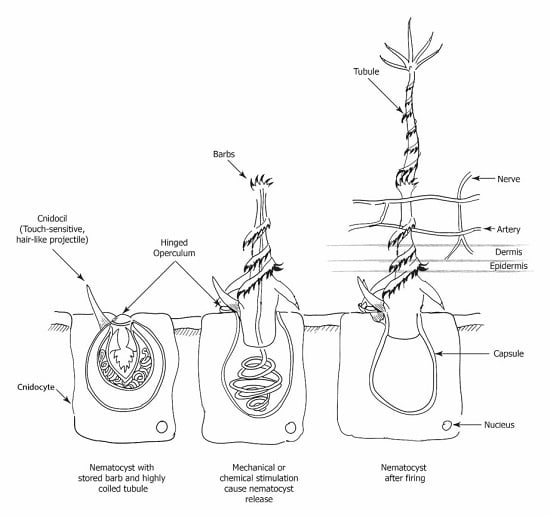To Pee, or Not to Pee: A Review on Envenomation and Treatment in European Jellyfish Species
Abstract
:1. Introduction
2. Methods
3. The Organisms
3.1. Anatomy and Physiology of the Stinging Mechanism
3.2. Factors Involved during Envenomation
3.3. Venom Constituents and Actions
4. Human Pathophysiology after Envenomation
4.1. Cutaneous and Systemic Symptoms
4.2. Immune Response
5. Treatment
- (1)
- Rescue and life-saving measures to ensure the patient is responsive and stable (Basic Life Support, Epinephrine injection);
- (2)
- Ensure victim stays relaxed and still to prevent venom circulation;
- (3)
- Administer oral analgesic;
- (4)
- Wash tentacles off with seawater, NOT freshwater;
- (5)
- ONLY for Carybdea marsupialis (Cubozoa) or Chrysaora hysoscella (Scyphozoa) shown in Figure 6: Immerse area in vinegar (4%–6% acetic acid) for at least 30 s;
- (6)
- Remove clinging tentacles (if possible, not with bare hands);
- (7)
- Apply baking soda slurry (50% sodium bicarbonate and 50% seawater) for several minutes and rinse off with seawater;
- (8)
- Immerse the affected area in continuous 42–45 °C water for 30 min or till pain is suppressed;
- (9)
- Hospitalization is required if onset of systemic symptoms or intense pain does not subside;
- (10)
- Symptomatic treatment: Antihistamine/Topical steroids/Immunomodulatory drugs.
6. Avoidance
7. Discussion
7.1. Envenomation
7.2. Treatment
8. Conclusions
Acknowledgments
Author Contributions
Conflicts of Interest
Abbreviations
| EBM | evidence-based medicine |
| WOK | Web of Knowledge |
| WoRMS | World Register of Marine Species |
| NRF | no reports found |
| NA | North Atlantic |
| E | Europe-wide |
| MS | Mediterranean Sea |
| NS | North Sea |
| CS | Celtic Sea |
| IS | Irish Sea |
| BS | Black Sea |
| Ig | Immunoglobulin |
| IV | Intravenous |
| PIB | pressure inducing bandages |
| A.a. | Aurelia aurita |
| C.h. | Chrysaora hysoscella |
| C.c. | Cyanea capillata |
| P.n. | Pelagia noctiluca |
| R.p. | Rhizostoma pulmo |
| R.n. | Rhopilema nomadica |
| C.m. | Carybdea marsupialis |
| P.p. | Physalia physalis |
| DJES | delayed jellyfish envenomation syndrome |
| TOE | tentacle-only extract |
References
- Boero, F. Review of jellyfish blooms in the Mediterranean and Black Sea. FAO 2013, 92, 1–53. [Google Scholar]
- Condon, R.H.; Duarte, C.M.; Pitt, K.A.; Robinson, K.L.; Lucas, C.H.; Sutherland, K.R.; Mianzan, H.W.; Bogeberg, M.; Purcell, J.E.; Decker, M.B.; et al. Recurrent jellyfish blooms are a consequence of global oscillations. PNAS 2013, 110, 1000–1005. [Google Scholar] [CrossRef] [PubMed]
- Mills, C.E. Jellyfish blooms: Are populations increasing globally in response to changing ocean conditions? Hydrobiologia 2001, 451, 55–68. [Google Scholar] [CrossRef]
- Purcell, J.E. Climate effects on formation of jellyfish and ctenophore blooms: A review. J. Mar. Biol. Assoc. UK 2005, 85, 461–476. [Google Scholar] [CrossRef]
- Van Walraven, L.; Langenberg, V.T.; Dapper, R.; Witte, J.I.J.; Zuur, A.F.; van der Veer, H.W. Long-term patterns in 50 years of scyphomedusae catches in the western Dutch Wadden Sea in relation to climate change and eutrophication. J. Plankton Res. 2015, 37, 151–167. [Google Scholar] [CrossRef]
- Wiebring, A.; Helmholz, H.; Lassen, S.; Prange, A.; Jarms, G. Separation and analysis of different types of nematocysts from Cyanea capillata (L.) medusa. Hydrobiologia 2010, 640, 203–212. [Google Scholar] [CrossRef]
- Cegolon, L.; Heymann, W.C.; Lange, J.H.; Mastrangelo, G. Jellyfish Stings and Their Management: A Review. Mar. Drugs 2013, 11, 523–550. [Google Scholar] [CrossRef] [PubMed]
- Reese, E.; Depenbrock, P. Water Envenomations and Stings. ACSM 2014, 13, 126–131. [Google Scholar] [CrossRef] [PubMed]
- Tibballs, J. Australian venomous jellyfish, envenomation syndromes, toxins and therapy. Toxicon 2006, 48, 830–859. [Google Scholar] [CrossRef] [PubMed]
- Williamson, J.A.; Fenner, P.J.; Burnett, J.W.; Rifkin, J.F. Venomous and Poisonous Marine Animals: A Medical and Biological Handbook; University of New South Wales Press: Sydney, Australia, 1996; pp. 63–306. [Google Scholar]
- Winkel, K.D.; Hawdon, G.M.; Fenner, P.J.; Gershwin, L.; Collins, A.G.; Tibballs, J. Jellyfish Antivenoms: Past, Present, and Future. J. Toxicol. 2003, 22, 115–127. [Google Scholar] [CrossRef]
- Wang, B.; Zhang, L.; Zheng, J.; Wang, Q.; Wang, T.; Lu, J.; Wen, X.; Zhang, B.; Liu, G.; Zhang, W.; et al. Multiple organ dysfunction: A delayed envenomation syndrome caused by tentacle extract from jellyfish Cyanea capillata. Toxicon 2013, 61, 54–61. [Google Scholar] [CrossRef] [PubMed]
- De Donno, A.; Idolo, A.; Bagordo, F.; Grassi, T.; Leomanni, A.; Serio, F.; Guido, M.; Canitano, M.; Zampardi, S.; Boero, F.; et al. Impact of Stinging Jellyfish Proliferations along South Italian Coasts: Human Health Hazards, Treatment and Social Costs. Int. J. Environ. Res. Public Health 2014, 11, 2488–2503. [Google Scholar] [CrossRef] [PubMed]
- Fenner, P.J. Awareness, Prevention and Treatment of world-wide marine stings and bites. In Proceedings of the International Life Saving Federation Medical/Rescue Conference, San Diego, CA, USA, 15–17 September 1997; pp. 73–83.
- White, J.; (Women’s & Children’s Hospital, Adelaide, Australia). Personal communication, 2015.
- Burnett, J.W.; (University of Maryland, Baltimore, MD, USA). Personal communication, 2015.
- Yanagihara, A.A.; Wilcox, C.; King, R.; Hurwitz, K.; Castelfranco, A.M. Experimental Assays to Assess the Efficacy of Vinegar and Other Topical First-Aid Approaches on Cubozoan (Alatina alata) Tentacle Firing and Venom Toxicity. Toxins 2016, 8, 1–21. [Google Scholar] [CrossRef] [PubMed]
- Burnett, J.W. Clinical manifestations of jellyfish envenomation. Hydrobiologia 1991, 216/217, 629–635. [Google Scholar] [CrossRef]
- Mariottini, G.L.; Pane, L. Mediterranean Jellyfish Venoms: A Review on Scyphomedusae. Mar. Drugs 2010, 8, 1122–1152. [Google Scholar] [CrossRef] [PubMed]
- Web of Science. Available online: https://webofknowledge.com (accessed on 5 March 2016).
- World Register of Marine Species (WoRMS). Available online: http://www.marinespecies.org (accessed on 18 April 2016).
- Jelly Risk. Jellyfish Identification Guide. Available online: http://jellyrisk.eu/en/downloads/ (accessed on 21 March 2016).
- Auerbach, P.S. Envenomations from jellyfish and related species. J. Emerg. Nurs. 1997, 23, 556–567. [Google Scholar] [CrossRef]
- Heins, A.; Glatzel, T.; Holst, S. Revised descriptions of nematocysts and the asexual reproduction modes of the scyphozoan jellyfish Cassiopea andromeda (Forskål, 1775). Zoomorphology 2015, 134, 351–366. [Google Scholar] [CrossRef]
- Junior, V.H.; Virga, R.; Bechara, A.; Lang da Silveira, F.; Morandini, A.C. An outbreak of Portuguese man-of-war (Physalia physalis—Linnaeus, 1958) envenoming in Southeastern Brazil. Rev. Soc. Bras. Med. Trop. 2013, 46, 641–644. [Google Scholar] [CrossRef] [PubMed]
- Tibballs, J.; Yanagihara, A.A.; Turner, H.C.; Winkel, K. Immunological and Toxicological Responses to Jellyfish Stings. Inflamm. Allergy Drug Targets 2011, 10, 438–446. [Google Scholar] [CrossRef] [PubMed]
- Avian, M.; Del Negro, P.; Sandrini, L.R. A comparative analysis of nematocysts in Pelagia noctiluca and Rhizostoma pulmo from the North Adriatic Sea. Hydrobiologia 1991, 216/217, 615–621. [Google Scholar] [CrossRef]
- Avian, M.; Spanier, E.; Galil, B. Nematocysts of Rhopilema nomadica (Scyphozoa: Rhizostomeae), An Immigrant Jellyfish in the Eastern Mediterranean. J. Morphol. 1995, 224, 221–231. [Google Scholar] [CrossRef]
- Birsa, L.M.; Verity, P.G.; Lee, R.F. Evaluation of the effects of various chemicals on discharge of and pain caused by jellyfish nematocysts. Comp. Biochem. Physiol. C 2010, 151, 426–430. [Google Scholar] [CrossRef] [PubMed]
- Burnett, J.W.; Calton, G.J. Jellyfish Envenomation Syndromes Updated. Ann. Emerg. Med. 1987, 16, 117–122. [Google Scholar] [CrossRef]
- Heeger, T.; Möller, H.; Mrowietz, U. Protection of human skin against jellyfish (Cyanea capillata) stings. Mar. Biol. 1992, 113, 669–678. [Google Scholar] [CrossRef]
- Wang, B.; Zhang, B.; Huo, H.; Wang, T.; Wang, Q.; Wu, Y.; Xiao, L.; Ren, Y.; Zhang, L. Detection of microvasculature alterations by synchrotron radiation in murine with delayed jellyfish envenomation syndrome. Toxicon 2014, 81, 48–53. [Google Scholar] [CrossRef] [PubMed]
- Burnett, J.W.; Calton, G.J. Letter to the Editor: The case for verapamil use in alarming jellyfish stings remains. Toxicon 2004, 44, 817–818. [Google Scholar] [CrossRef] [PubMed]
- Badré, S. Bioactive toxins from stinging jellyfish. Toxicon 2014, 91, 114–125. [Google Scholar] [CrossRef] [PubMed]
- Long, K.; Burnett, J.W. Isolation, characterization, and comparison of haemolytic peptides in nematocyst venoms of two species of jellyfish (Chrysaora quinquecirrha and Cyanea capillata). Comp. Biol. Physiol. B 1989, 94, 641–646. [Google Scholar]
- Tytgat, J.; (University of Leuven, Leuven, Belgium). Personal communication, 2015.
- Berling, I.; Isbister, G. Marine envenomations. AFP 2015, 44, 28–32. [Google Scholar]
- Burnett, J.W.; Calton, G.J.; Burnett, H.W. Jellyfish envenomation syndromes. J. Am. Acad. Dermatol. 1986, 14, 100–106. [Google Scholar] [CrossRef]
- Burnett, J.W. Medical aspects of jellyfish envenomation: Pathogenesis, case reporting, and therapy. Hydrobiologia 2001, 451, 1–9. [Google Scholar] [CrossRef]
- Walker, M.J.A.; Martinez, T.T.; Godin, V.D. Investigations into the cardiotoxicity of a toxin from the nematocysts of the jellyfish, Cyanea capillata. Toxicon 1976, 15, 339–346. [Google Scholar] [CrossRef]
- Stein, M.R.; Marraccini, J.V.; Rothschild, N.E.; Burnett, J.W. Fatal Portuguese Man-O’-War. Ann. Emerg. Med. 1989, 18, 312–315. [Google Scholar] [CrossRef]
- Hale, G. The Classification and Distribution of the Class Scyphozoa. In BI 375—Biological Diversity; University of Oregon: Eugene, OR, USA, 1999; pp. 1–43. [Google Scholar]
- Radwan, F.F.Y.; Burnett, J.W.; Bloom, D.A.; Coliano, T.; Eldefrawi, M.E.; Erderly, H.; Aurelian, L.; Torres, M.; Heimer-de la Cotera, E.P. A comparison of toxinological characteristics of two Cassiopea and Aurelia species. Toxicon 2001, 39, 245–257. [Google Scholar] [CrossRef]
- Encyclopedia of Life (EOL). Available online: http://www.eol.org (accessed on 21 March 2016).
- Kang, C.; Jin, Y.B.; Kwak, J.; Jung, H.; Yoon, W.D.; Yoon, T.; Kim, J.; Kim, E. Protective Effect of Tetracycline against Dermal Toxicity Induced by Jellyfish Venom. PLoS ONE 2013, 8, e57658. [Google Scholar] [CrossRef] [PubMed]
- Mariottini, G.L.; Pane, L. Cytotoxic and Cytolytic Cnidarian Venoms. A Review on Health Implications and Possible Therapeutic Applications. Toxins 2013, 6, 108–151. [Google Scholar] [CrossRef] [PubMed]
- Russo, A.J.; Calton, G.J.; Burnett, J.W. The relationship of the possible allergic response to jellyfish envenomation and serum antibody titers. Toxicon 1983, 21, 475–480. [Google Scholar] [CrossRef]
- Holst, S.; Laakmann, S. Morphological and molecular discrimination of two closely related jellyfish species, Cyanea capillata and C. lamarckii (Cnidaria, Scyphozoa), from the northeat Atlantic. J. Plankton Res. 2014, 36, 48–63. [Google Scholar] [CrossRef]
- Larson, R.J.; Madin, L.P.; Harbison, G.R. In situ observations of Deepwater medusae in the genus Deepstaria, with a description of D. reticulum, sp. nov. J. Mar. Biol. Assoc. UK 1998, 68, 689–699. [Google Scholar] [CrossRef]
- Marine Species Identification Portal. Available online: http://species-identification.org/species.php?species_group=zsao&id=2423 (accessed on 22 March 2016).
- Piraino, S.; Aglieri, G.; Martell, L.; Mazzaldi, C.; Melli, V.; Milisenda, G.; Scorrano, S.; Boero, F. Pelagia benovici sp. nov. (cnidaria, Scyphozoa): A new jellyfish in the Mediterranean Sea. Zootaxa 2014, 3794, 455–468. [Google Scholar] [CrossRef] [PubMed]
- Ayed, Y.; Bouaziz, C.; Brahmi, D.; Zaid, C.; Abid, S.; Bacha, H. Cell Death in Relation to DNA Damage After Exposure to the Jellyfish Pelagia noctiluca nematocysts. Environ. Toxicol. 2014, 29, 337–344. [Google Scholar] [CrossRef] [PubMed]
- Ayed, Y.; Bouaziz, C.; Hayla, A.; Abid, S.; Bacha, H. Is Cell Death Induced by Nematocysts Extract of Medusa Pelagia noctiluca Related to Oxidative Stress? Environ. Toxicol. 2011, 28, 498–506. [Google Scholar] [CrossRef] [PubMed]
- Burnett, J.W.; Gable, W.D. A fatal jellyfish envenomation by the Portuguese Man-O’War. Toxicon 1989, 27, 823–824. [Google Scholar] [CrossRef]
- Pang, K.A.; Schwartz, M.S. Guillain-Barré syndrome following jellyfish stings (Pelagia noctiluca). JNNP 1993, 56, 1133–1137. [Google Scholar] [CrossRef]
- Togias, A.G.; Burnett, J.W.; Kagey-Sobotka, A.; Lichtenstein, L.M. Anaphylaxis after contact with a jellyfish. J. Allergy Clin. Immunol. 1985, 75, 672–675. [Google Scholar] [CrossRef]
- Widmer, C.L. Life cycle of Phacellophora camtschatica (Cnidaria: Scyphozoa). Invert. Biol. 2006, 125, 83–90. [Google Scholar] [CrossRef]
- Rodriguez, C.S.; Pujol, M.G.; Mianzan, H.W.; Genzano, G.N. First record of the invasive stinging medusa Gonionemus vertens in the southern hemisphere (Mar del Plata, Argentina). Lat. Am. J. Aquat. Res. 2014, 42, 653–657. [Google Scholar] [CrossRef]
- Loredana Asztalos, M.; Rubin, A.I.; Elenitsas, R.; Groft MacFarlnae, C.; Castelo-Soccio, L. Recurrent Dermatitis and Dermal Hypersensitivity Following a Jellyfish Sting: A Case Report and Review of Literature. Pediatr. Dermatol. 2014, 31, 217–219. [Google Scholar] [CrossRef] [PubMed]
- Burnett, J.W.; Calton, G.J.; Burnett, H.W.; Mandojana, R.M. Local and Systemic Reactions from Jellyfish Stings. Clin. Dermatol. 1987, 5, 14–28. [Google Scholar] [CrossRef]
- Burnett, J.W. Dysphonia: A New Addition to Jellyfish Envenomation Syndromes. Wild. Environ. Med. 2005, 16, 117–118. [Google Scholar] [CrossRef]
- Schmitt, C.; de Haro, L. Clinical Marine Toxicology: A European Perspective for Clinical Toxicologists and Poison Centers. Toxins 2013, 5, 1343–1352. [Google Scholar] [CrossRef] [PubMed]
- Månsson, T.; Randle, H.W.; Mandojana, R.M.; Calton, G.J.; Burnett, J.W. Recurrent Cutaneous Jellyfish Eruptions without Envenomation. Acta Derm. Venereol. 1985, 65, 72–75. [Google Scholar] [PubMed]
- Kokelj, F.; Burnett, J.W. Treatment of pigmented lesion induced by a Pelagia noctiluca sting. Cutis 1990, 46, 62–64. [Google Scholar] [PubMed]
- Cuypers, E.; Yanagihara, A.; Karlsson, E.; Tytgat, J. Jellyfish and other cnidarian envenomations cause pain by affecting TRPV1 channels. FEBS Lett. 2006, 580, 5728–5732. [Google Scholar] [CrossRef] [PubMed]
- Morabito, R.; Marino, A.; Dossena, S.; la Spada, G. Nematocyst discharge in Pelagia noctiluca (Cnidaria, Scyphozoa) oral arms can be affected by lidocaine, ethanol, ammonia and acetic acid. Toxicon 2014, 83, 52–58. [Google Scholar] [CrossRef] [PubMed]
- Obis, E.; (LIFE CUBOMED project (LIFE08 NAT/ES/0064), Barcelona, Spain). Personal communication, 2016.
- Piraino, S.; Deidun, A.; Fuentes, V.; Yahia, M.N.D.; Yahia, O.D.; Marambio, M.; Canepa, A.; Olariaga, A.; Gueroun, S.; Aissi, M.; et al. Are anti-jellyfish nets a useful mitigation tool for coastal tourism? Hindsight from the MED-JELLYRISK experience. In Proceedings of the 5th International Jellyfish Bloom Symposium, Barcelona, Spain, 30 May–3 June 2016.
- Marambio, M.; Lόpez, L.; Yahia, O.K.D.; Yahia, N.D.; Deidun, A.; Piraino, S.; Nunes, P.A.L.D.; Fuentes, V. The Medjelly App: A preventive and mitigation tool against jellyfish blooms involving a citizen science network. In Proceedings of the 5th International Jellyfish Bloom Symposium, Barcelona, Spain, 30 May–3 June 2016.
- Colin, S.P.; Costello, J.H. Functional characteristics of nematocysts found on the scyphomedusa Cyanea capillata. J. Exp. Mar. Biol. Ecol. 2007, 351, 114–120. [Google Scholar] [CrossRef]
- Dawson, M.N. Macro-morphological variation among cryptic species of the moon jellyfish, Aurelia (Cnidaria: Scyphozoa). Mar. Biol. 2003, 143, 369–379. [Google Scholar] [CrossRef]
- Purcell, J.E.; Uye, S.; Lo, W. Anthropogenic cause of jellyfish blooms and their direct consequences for humans: A review. MEPS 2007, 350, 153–174. [Google Scholar] [CrossRef]
- Morabito, R.; Dossena, S.; la Spada, G.; Marino, A. Heavy Metals Affect Nematocysts Discharge Response and Biological Activity of Crude Venom in the Jellyfish Pelagia noctiluca (Cnidaria, Scyphozoa). Cell. Physiol. Biochem. 2014, 34, 244–254. [Google Scholar] [CrossRef] [PubMed]
- Morabito, R.; Marino, A.; Romano, P.; Rigano, C.; la Spada, G. Sulphate and Chloride-Dependent Potassium Transport in Human Erythrocytes are Affected by Crude Venom from Nematocysts of the Jellyfish Pelagia noctiluca. Cell. Physiol. Biochem. 2013, 32, 86–95. [Google Scholar] [CrossRef] [PubMed]
- Xiao, L.; Zhang, J.; Wang, Q.Q.; He, Q.; Liu, S.H.; Li, Y.; Zhang, L.M. In vitro and in vivo haemolytic studies of tentacle-only extract from jellyfish Cyanea capillata. Toxicol. In Vitro 2010, 24, 1203–1207. [Google Scholar] [CrossRef] [PubMed]
- Pereira, P.L.; Carrette, T.; Cullen, P.; Mulcahy, R.F.; Little, M.; Seymour, J. Pressure immobilisation bandages in first-aid treatment of jellyfish envenomation: Current recommendations reconsidered. Med. J. Aust. 2000, 173, 650–652. [Google Scholar] [PubMed]
- Xiao, L.; He, Q.; Guo, Y.; Zhang, J.; Nie, F.; Li, Y.; Ye, X.; Zhange, L. Cyanea capillata tentacle-only extract as a potential alternative of nematocyst venom: Its cardiovascular toxicity and tolerance to isolation and purification procedures. Toxicon 2009, 53, 146–152. [Google Scholar] [CrossRef] [PubMed]
- Mariottini, G.L. Hemolytic venoms from marine cnidarian jellyfish—An overview. J. Venom Res. 2014, 5, 22–32. [Google Scholar] [PubMed]
- Hamann, C.R.; Hamann, D.; Richardson, C.; Seeburger, J. Box jellyfish envenomation: Case report of effective lemon and oil emulsion treatment. Trop. Dr. 2014, 44, 106–107. [Google Scholar] [CrossRef] [PubMed]
- Atkinson, P.R.T.; Boyle, A.; Hartin, D.; McAuley, D. Is hot water immersion an effective treatment for marine envenomation? Emerg. Med. J. 2006, 23, 503–508. [Google Scholar] [CrossRef] [PubMed]
- Li, L.; McGee, R.G.; Isbister, G.K.; Webster, A.C. Interventions for the symptoms and signs resulting from jellyfish stings (Review). Cochrane Collab. 2013, 12, 2–36. [Google Scholar]
- Loten, C.; Stokes, B.; Worsley, D.; Seymour, J.E.; Jiang, S.; Isbister, G.K. A randomised controlled trial of hot water (45 °C) immersion versus ice packs for pain relief in blue bottle stings. Med. J. Aust. 2006, 184, 329–333. [Google Scholar] [PubMed]
- Yoshimoto, C.M.; Yanagihara, A.A. Cnidarian (coelenterate) envenomations in Hawai’i improve following heat application. Trans. R. Soc. Trop. Med. Hyg. 2002, 96, 300–303. [Google Scholar] [CrossRef]


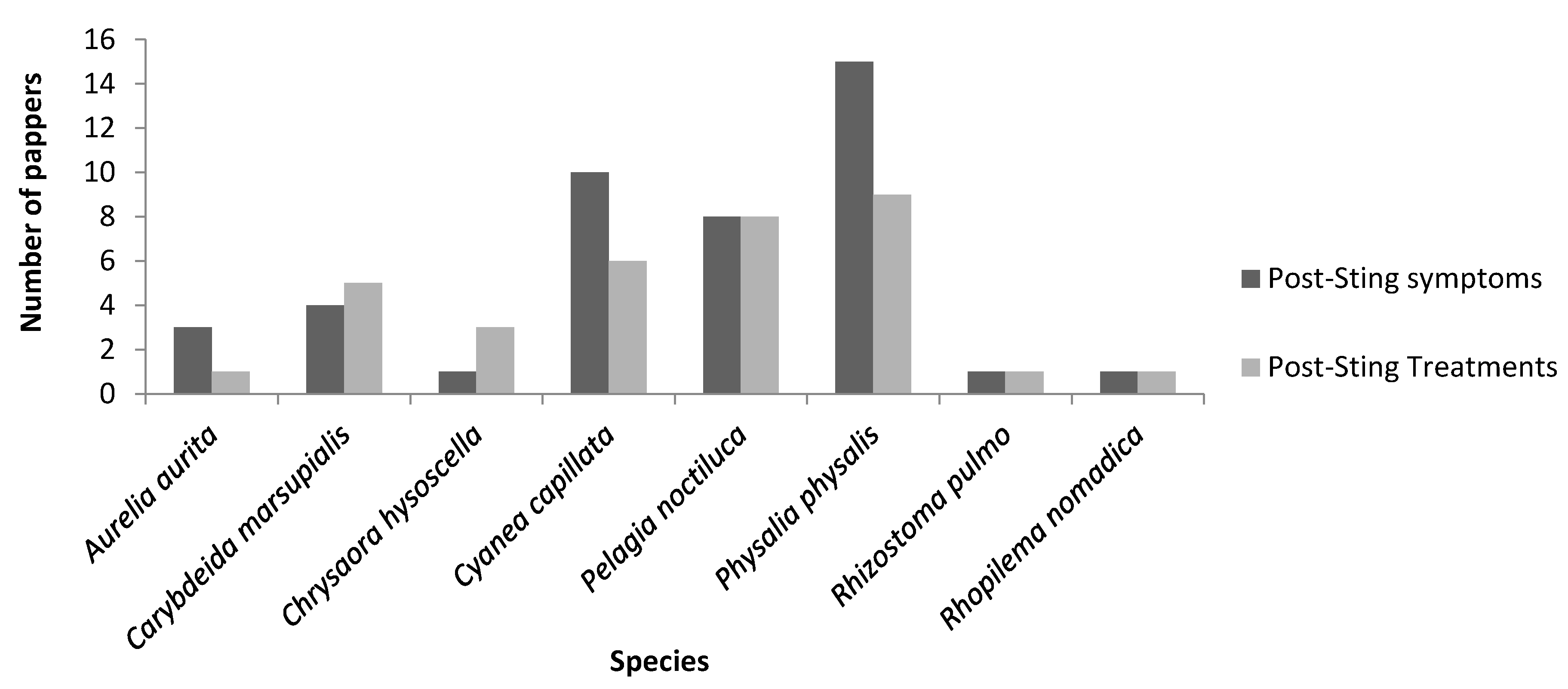
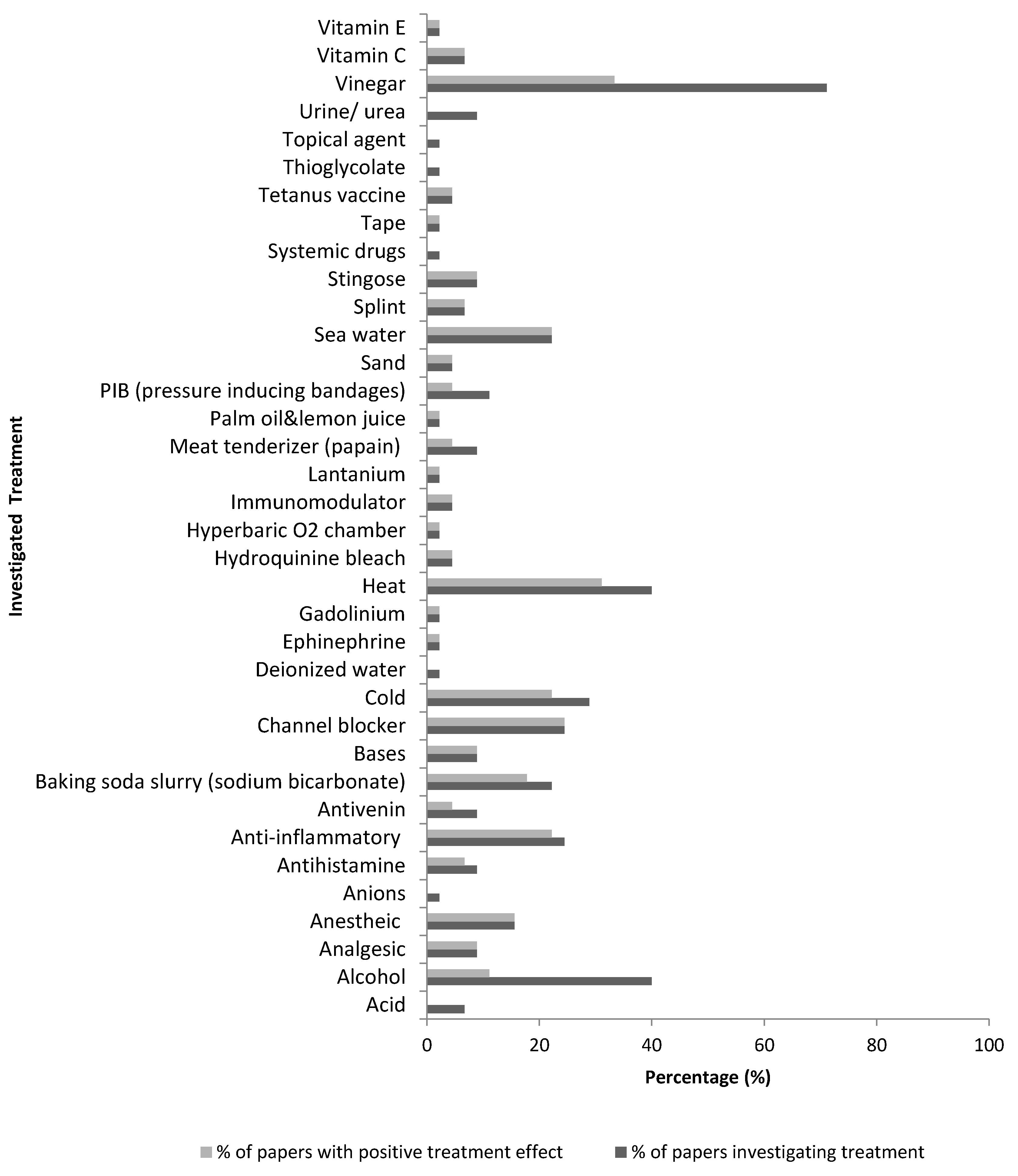
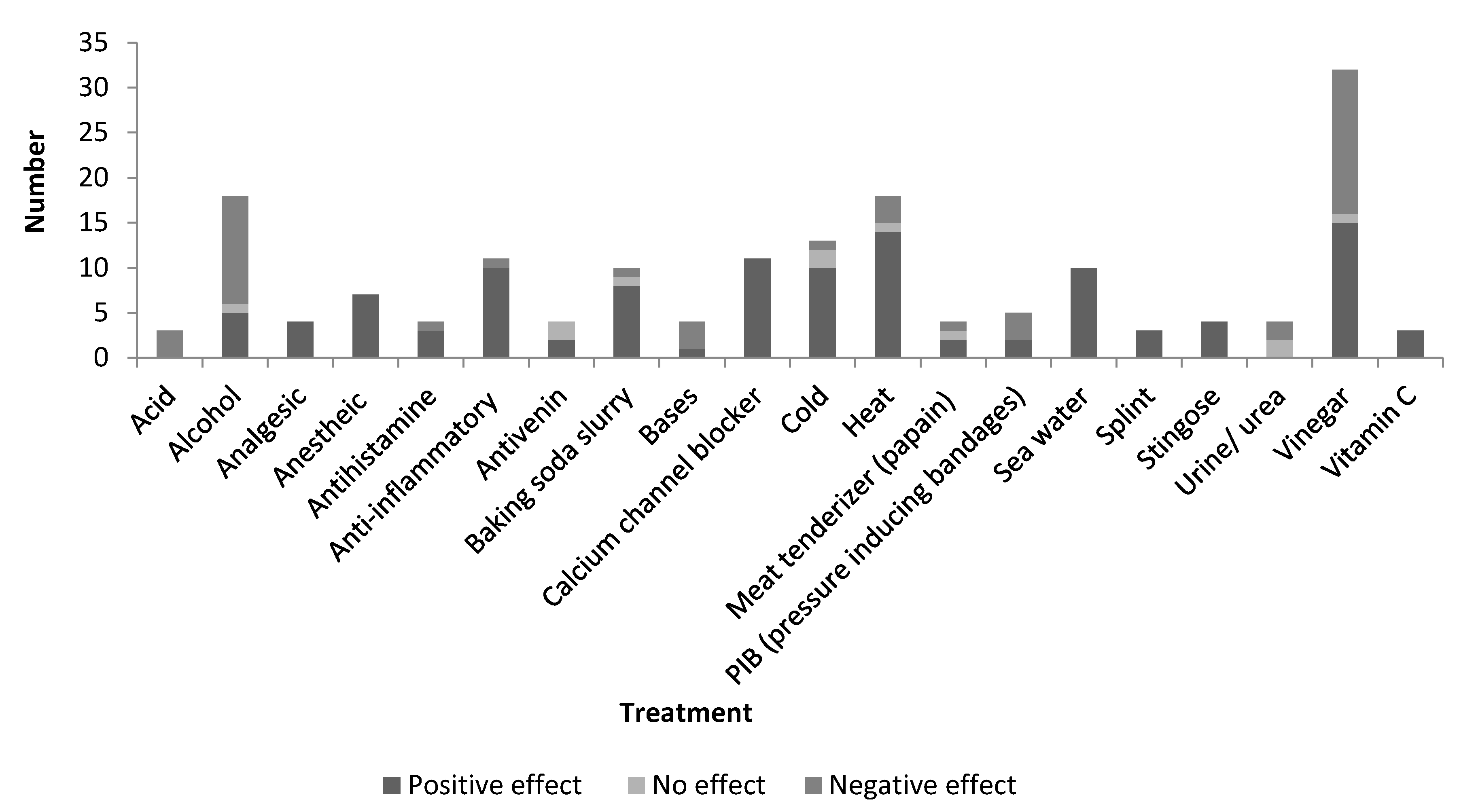
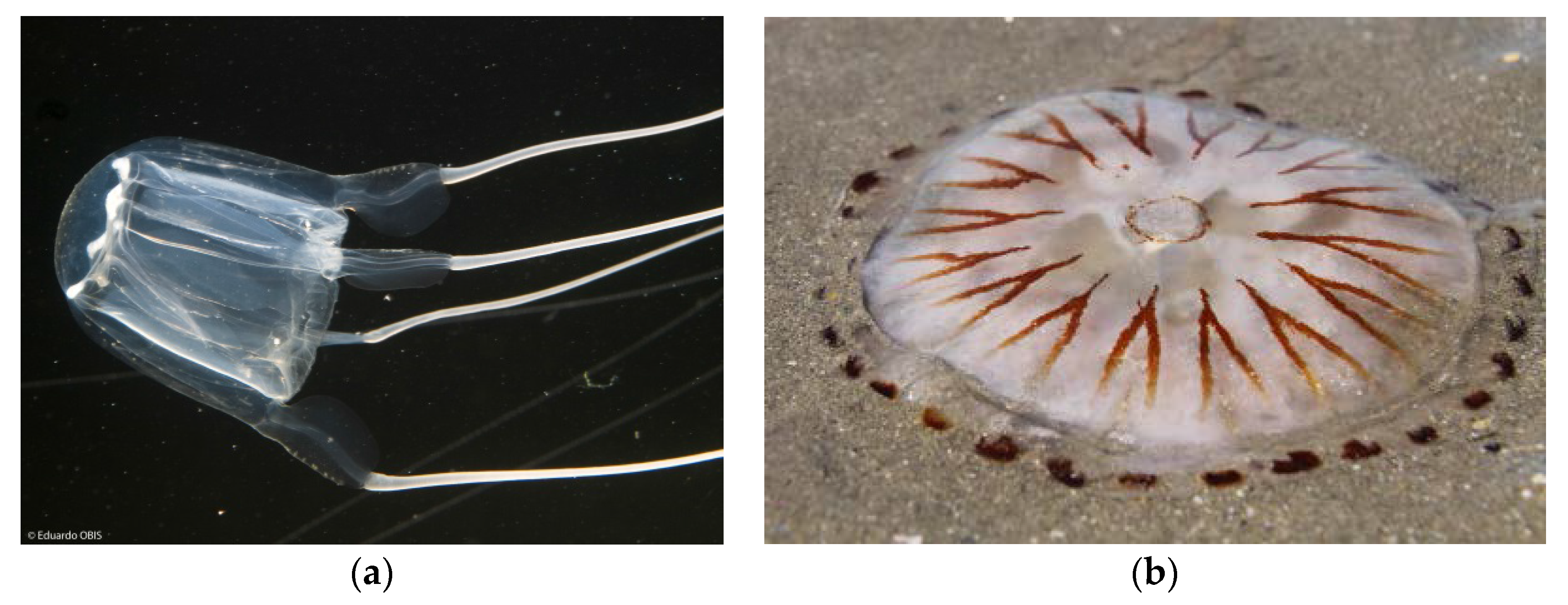
| Species | Sting Severity | Species Frequency | Area | Cutaneous Symptom | Systemic Symptom | Post-Sting Marking | Reference |
|---|---|---|---|---|---|---|---|
| Scyphozoa | |||||||
| Atolla sp. | Mild | Low | NA | NRF | NRF | NRF | [42] |
| Atorella subglobosa | Mild | Very low | NA | NRF | NRF | NRF | [42] |
| Aurelia aurita | Mild | High | E | Dermatitis Hives Pain Piloerection | NRF | NRF | [9,19,22,34] |
| Cassiopea andromeda | Mild | High | MS NA | NRF | NRF | NRF | [19,22,43] |
| Catostylus tagi | Mild | Low | NA | NRF | NRF | NRF | [21,44] |
| Chrysaora hysoscella | High | Low | CS IS MS NS | Wheals Punctuate erythematous rash | NRF | Multiple punctate linear wheals; Pink macules which coalesce; Discontinuous line of regularly distributed small papules surrounded by erythematous halo | [9,22,28] |
| Cotylorhiza tuberculata | Mild | High | MS NA | NRF | NRF | NRF | [19,22] |
| Cyanea capillata | Severe* | High | MS NA NS | Burning Edema Erythema Irritations Pain Wheals | Abdominal pain Cardiac complications Dizziness Drowsiness Hemolysis of red blood cells Impaired consciousness Organ failure Muscular cramp Nausea Pain Profuse sweating Respiratory distress | Red erythematous stripes; Fine, stippled, linear wheal bordered by narrow flare: circular saw tooth pattern wheal | [7,9,12,23,32,34,40,45,46,47] |
| Cyanea lamarckii | Mild | High | NA NS | NRF | NRF | NRF | [48] |
| Deepstaria enigmatica | Mild | Very low | NA | NRF | NRF | NRF | [49] |
| Discomedusa lobata | Mild | Very low | MS | NRF | NRF | NRF | [19,22] |
| Drymonema dalmatinum | High | Very low | NA | NRF | NRF | NRF | [22] |
| Marivagia stella | Mild | Low | MS | NRF | NRF | NRF | [22] |
| Nausithoe sp. | Mild | Low | NA | NRF | NRF | NRF | [19] |
| Paraphyllina ransoni | Mild | Low | MS NA | NRF | NRF | NRF | [50] |
| Pelagia benovici | Medium | Low | MS | NRF | NRF | NRF | [51] |
| Pelagia noctiluca | High | Very high | MS | Burning Dermatitis Edema Erythema Hives Hyperpig-mentation Lesions Pain Vesicles | Anaphylaxis Dizziness Diarrhea Dyspnea Guillian Bare-Syndrome Hypotension Shock Vomiting | NRF | [9,10,19,22,34,38,39,52,53,54,55,56] |
| Periphylla periphylla | Mild | Low-High | NA | NRF | NRF | NRF | [44] |
| Phacellophora camtschatica | Mild | Low | NA MS | NRF | NRF | NRF | [44,57] |
| Phyllorhiza punctata | Mild | Low | MS | NRF | NRF | NRF | [22] |
| Poralia rufescens | NRF | Low | NS | NRF | NRF | NRF | [44] |
| Rhizostoma pulmo (Rhizostoma octopus) | Mild | High | BS IS NS MS | Erythema Pain | NRF | NRF | [19,22] |
| Rhopilema luteum | Medium | Very low | MS NA | NRF | NRF | NRF | [22] |
| Rhopilema nomadica | Medium | High | MS | Burning pain Erythematous eruptions | Delayed cutaneous reactions Fatigue Fever Muscular aches | NRF | [19,22,34] |
| Rhopilema rhopalophora | NRF | Rare | NA | NRF | NRF | NRF | [21] |
| Stephanoscyphus mirablis | NRF | Rare | NA | NRF | NRF | NRF | [21] |
| Stygiomedusa gigantea | NRF | Rare | NA | NRF | NRF | NRF | [21] |
| Cubozoa | |||||||
| Carybdea marsupialis | High | High | MS NA | Inflammation Pain | Cardiac complications Irukandji syndrome Muscular cramps Neurological complications | NRF | [7,22,25,34,41] |
| Hydrozoa | |||||||
| Gonionemus vertens | Medium | High | MS NA NS | Burning pain Edema | Convulsions Disturbed respiration Neuro-psychiatric changes | NRF | [22,58] |
| Olindias phosphorica | Medium | Low | MS NA | NRF | NRF | NRF | [22] |
| Physalia physalis | Severe * | High | MS NA | Atrophy of subcutaneous tissue Blistering Edema Erythema Hyper-pigmentation Inflammation Keloids Lesions Linear plaques pain Long lasting dermal marks Necrosis Pain Pigmentation Pruritus Recurrent rash | Abdominal pain Anaphylaxis Angioedema Coma Confusion Cardiac complications Cold sweats Cyanosis Death Diarrhea Drowsiness Dyspnea Fainting Gastro-intestinal allergies Headache Haemolysis Hysteria Irukandji syndrome Joint pain Muscular spasm Nausea/Vomiting Neurological complications Nervousness Organ failure (kidney/liver) Pallor Parasympath-etic dystopia Reactive arthritis Respiratory complications | Linear line of lesions (like a row of beans); Segmented/banded/crossed skin wheals | [7,8,9,10,22,25,26,28,34,36,59,60,61,62] |
| Treatment | A.a. | C.h. | C.c. | P.n. | R.p. | R.n. | C.m. | P.p. |
|---|---|---|---|---|---|---|---|---|
| Acid | 1− | 1− | ||||||
| Alcohol | 1,1− | 1, 1− | 1− | 1, 3− | ||||
| Ammonia | 1+ | 1− | ||||||
| Analgesic | 1+ | |||||||
| Anesthetic | 1+ | 2+ | ||||||
| Anions | 1− | |||||||
| Antihistamine | 2+ | |||||||
| Anti-inflammatory | 1+ | 1+ | 6+ ,1− | |||||
| Antivenin | 1+ | 1 | ||||||
| Baking soda slurry | 3+ | 2+ | 1− | 2+, 1 | ||||
| Bases | 1− | |||||||
| Channel blocker | 4+ | 2+ | 2+ | 1+ | ||||
| Cold pack | 1 | 2+ | 2+ | 4+, 1 | ||||
| Heat | 1+ | 1+, 1 | 2+ | 1+, 1− | 1+ | 1+ | 4+, 2− | |
| Palm oil and Lemon juice | 1+ | |||||||
| Pressure inducing bandages (PIB) | 1, 1− | |||||||
| Sand | 1+ | |||||||
| Sea water | 1+ | 1+ | 2+ | 3+ | 1+ | |||
| Splint | 1+ | |||||||
| Stingose | 1+ | 1+ | 2+ | |||||
| Thioglycolate | 1− | |||||||
| Urine/urea | 1− | |||||||
| Vinegar | 1− | 1+ | 1+, 4− | 2+, 3− | 3+ | 6+, 1, 6− | ||
| Vitamin C | 1+ | |||||||
| Vitamin E | 1+ | |||||||
| A.a.: A. aurita; C.h.: C. hyscoscella; C.c.: C. capillata; P.n.: P. noctiluca; R.p.: R. pulmo; R.n.: R. nomadica; C.m.: C. marsupialis; P.p.: P. physalis. | ||||||||
| Key: | Overall positive effect (+) | Overall no effect | Overall negative effect (−) | |||||
© 2016 by the authors; licensee MDPI, Basel, Switzerland. This article is an open access article distributed under the terms and conditions of the Creative Commons Attribution (CC-BY) license (http://creativecommons.org/licenses/by/4.0/).
Share and Cite
Montgomery, L.; Seys, J.; Mees, J. To Pee, or Not to Pee: A Review on Envenomation and Treatment in European Jellyfish Species. Mar. Drugs 2016, 14, 127. https://doi.org/10.3390/md14070127
Montgomery L, Seys J, Mees J. To Pee, or Not to Pee: A Review on Envenomation and Treatment in European Jellyfish Species. Marine Drugs. 2016; 14(7):127. https://doi.org/10.3390/md14070127
Chicago/Turabian StyleMontgomery, Louise, Jan Seys, and Jan Mees. 2016. "To Pee, or Not to Pee: A Review on Envenomation and Treatment in European Jellyfish Species" Marine Drugs 14, no. 7: 127. https://doi.org/10.3390/md14070127
APA StyleMontgomery, L., Seys, J., & Mees, J. (2016). To Pee, or Not to Pee: A Review on Envenomation and Treatment in European Jellyfish Species. Marine Drugs, 14(7), 127. https://doi.org/10.3390/md14070127





